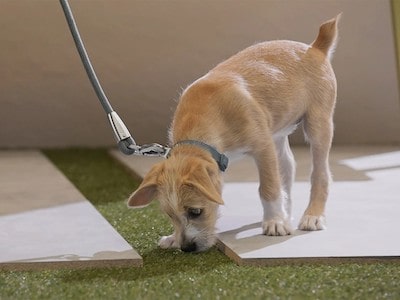As pet owners, one of the important aspects of caring for our furry companions is understanding their bodily needs. Among these needs, bathroom breaks play a significant role in maintaining their overall well-being. If you’ve ever wondered how long dogs can hold their pee, you’re not alone.

It’s a common question that arises when considering their bladder control and determining the appropriate potty schedules. In this article, we delve into the fascinating world of canine bladder control and explore the factors that influence how long dogs can hold their pee.
So, let’s embark on this journey to uncover the secrets behind Fido’s bathroom habits and gain a deeper understanding of their bladder capacity.
Factors That Affect How Long Dogs Can Hold Their Pee
How long dogs can hold their pee depends on several factors, such as:
- Age: Puppies and senior dogs have less bladder control than adult dogs and need to pee more often. Puppies can hold their pee for about an hour per month of age, up to eight hours. Senior dogs may have health conditions that affect their urinary system or weaken their bladder muscles.
- Size: Larger dogs have bigger bladders and can hold more urine than smaller dogs. However, this also depends on how much water they drink and how active they are.
- Breed: Some breeds are more prone to urinary problems than others. For example, Dalmatians are more likely to develop bladder stones, while Poodles are more susceptible to urinary tract infections.

- Health: Certain health conditions, such as diabetes, kidney disease, or urinary tract infections, can make your dog pee more often or have difficulty holding their pee. Some medications can also affect your dog’s urination habits.
- Diet: What your dog eats and drinks can influence how much and how often they pee. A high-quality diet that is appropriate for your dog’s age and size can help prevent urinary issues. Make sure your dog has access to fresh water at all times and avoid giving them salty or spicy foods that can irritate their bladder.
- Environment: The temperature, humidity, and season can affect your dog’s water intake and urination frequency. Dogs may drink more water in hot weather or when they exercise a lot. They may also pee more in cold weather or when they are nervous or excited.
- Training: How well your dog is potty trained can determine how long they can hold their pee. A well-trained dog will learn to signal when they need to go out and wait until they reach a suitable place to pee. A poorly trained dog may not know how to communicate their needs or may have accidents in the house.
Risks of Holding Pee for Too Long
Holding pee for too long can cause several health problems for your dog, such as:
- Urinary tract infections (UTIs): These are bacterial infections that affect the bladder, urethra, or kidneys. They can cause pain, inflammation, blood in the urine, difficulty peeing, or frequent urination. UTIs can be treated with antibiotics but may recur if not addressed properly.
- Bladder stones: These are hard deposits of minerals that form in the bladder. They can cause irritation, obstruction, infection, or bleeding in the urinary tract. Bladder stones may require surgery or dietary changes to remove or dissolve them.

- Kidney damage: If urine stays in the bladder for too long, it can back up into the kidneys and cause damage to the kidney tissue. This can lead to kidney failure, which is a life-threatening condition that requires immediate veterinary attention.
- Behavioral issues: Holding pee for too long can also affect your dog’s mental and emotional well-being. They may become stressed, anxious, depressed, or aggressive due to the discomfort and frustration of not being able to relieve themselves. They may also develop bad habits such as peeing in inappropriate places or marking their territory.
To prevent these problems, you should provide your dog with regular potty breaks and access to fresh water. If you notice any signs of urinary trouble in your dog, such as straining to pee, peeing more or less than usual, peeing in unusual places, blood in the urine, or foul-smelling urine, you should take them to the vet as soon as possible.
How to Potty Train Your Dog
Potty training your dog is essential for their health and happiness. It will also make your life easier and avoid unpleasant messes in your home. Here are some tips on how to potty train your dog:
- Start early: The best time to start potty training your puppy is when they are between 8 and 12 weeks old. This is when they are most receptive to learning new behaviors and habits.
- Establish a routine: Take your dog out for a potty break at regular intervals throughout the day. The frequency will depend on their age and needs, but generally you should take them out first thing in the morning, after meals, after naps, after playtime, and before bedtime.
- Choose a spot: Pick a designated spot for your dog to pee outside. This will help them associate that place with peeing and make it easier for them to learn where to go.
- Use cues: Use a word or phrase that signals your dog when it is time to pee. For example, you can say “go potty” or “do your business” when you take them out. Repeat this cue every time you want them to pee until they learn what it means.

- Reward success: Praise your dog and give them a treat every time they pee in the right place. This will reinforce the positive behavior and motivate them to repeat it.
- Avoid punishment: Never scold or hit your dog if they have an accident in the house. This will only make them fearful or confused and may worsen the problem. Instead, calmly clean up the mess and take them outside right away.
- Be patient: Potty training takes time and consistency. Don’t expect your dog to learn overnight or be perfect all the time. Be prepared for some setbacks and mistakes along the way and keep working with your dog until they master the skill.
FAQ
No, puppies have smaller bladders and less bladder control compared to adult dogs. They generally need to relieve themselves more frequently, typically every 2 to 4 hours, depending on their age.
There is some variation among dog breeds regarding their bladder control. Generally, smaller dog breeds tend to have smaller bladders and may need more frequent bathroom breaks compared to larger breeds. However, individual factors such as training and overall health also play a significant role.
Yes, holding pee for extended periods can potentially be harmful to dogs. It may lead to urinary tract infections, bladder stones, or even bladder ruptures in severe cases. It’s essential to establish a regular bathroom schedule to prevent such health issues.
Training and consistency are key factors in improving a dog’s bladder control. Establishing a routine for regular bathroom breaks, providing ample opportunities for outdoor elimination, and rewarding desired behaviors can help in strengthening their bladder control over time.
Conclusion
Understanding how long dogs can hold their pee is crucial for providing them with proper care and ensuring their comfort. While the average duration that dogs can hold their pee falls within the range of 4 to 6 hours, it’s important to remember that individual factors such as age, size, health condition, and training play a significant role in bladder control.
By being attentive to your dog’s behavior and recognizing the signs that they need to go to the bathroom, you can help prevent accidents and maintain their overall health. Establishing a regular bathroom schedule, providing ample opportunities for outdoor elimination, and consistently reinforcing positive behaviors through training can contribute to improving a dog’s bladder control over time.
If you notice any sudden changes in your dog’s ability to hold their pee or if they are experiencing frequent accidents, it’s advisable to seek guidance from a veterinarian. They can assess your dog’s specific situation, rule out any underlying health issues, and provide appropriate guidance or treatment if necessary.

Ellis is a retired veterinary technician and full-time contributor at DogLovesBest. He likes writing about pet health care tips and reviews the products that are useful for fidos on a daily basis.
Ellis also guardians a Siberian husky, Nova, and a cat named Shilly. They all live happily with his wife Ammy, and both the dogs on a seaside apartment in Queens, NY.
